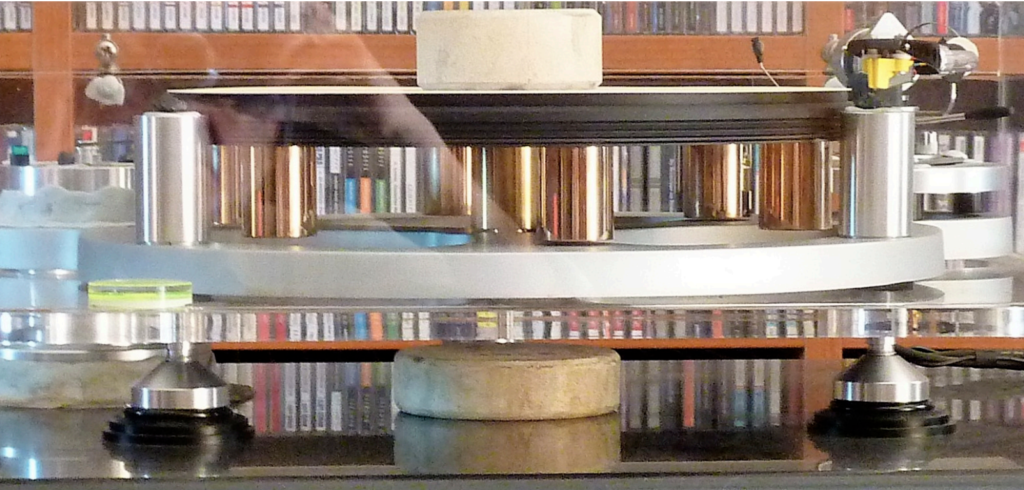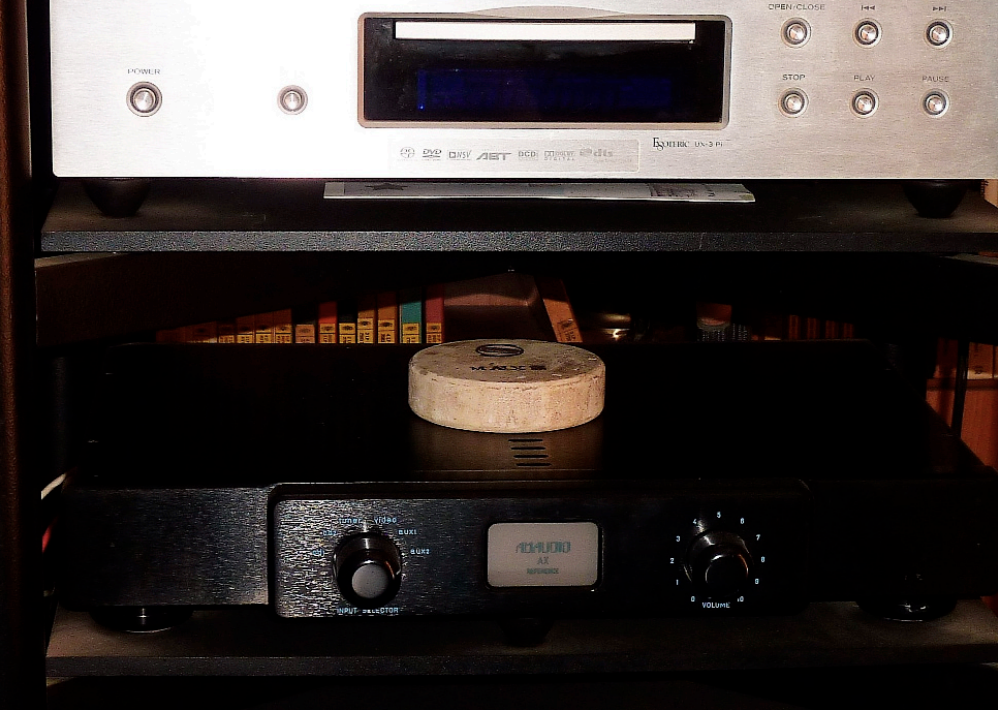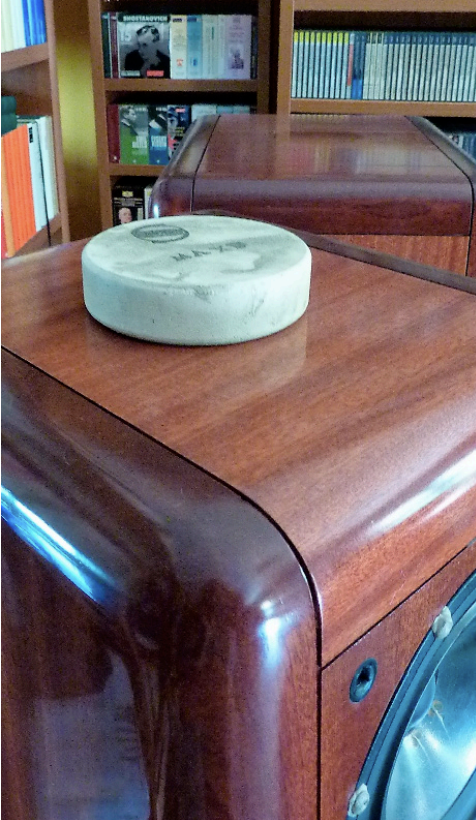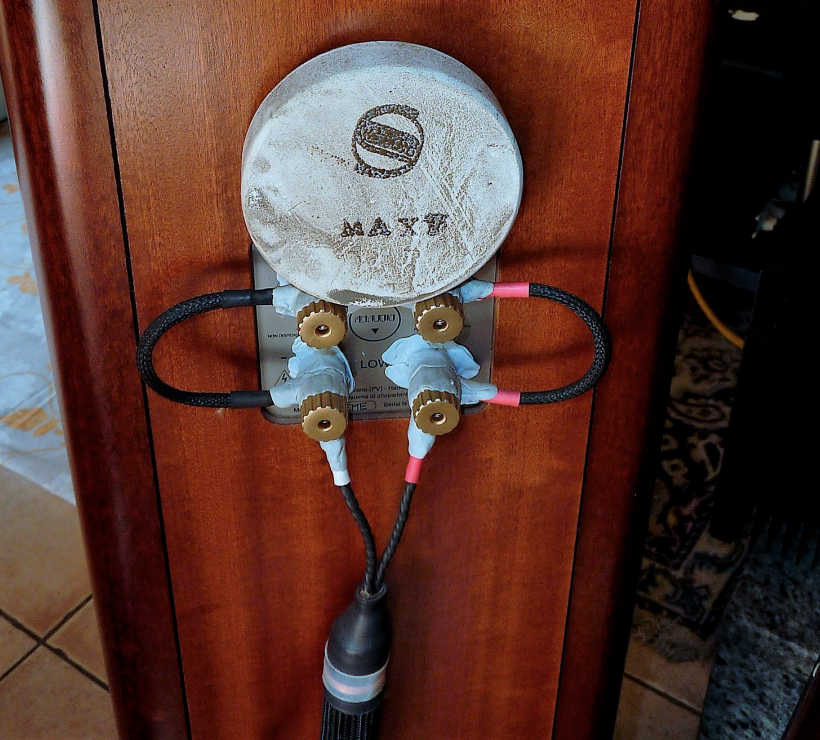Article from Audiophile No. 168 by Andrea Bedetti
Video Clip Link: Andre Bedetti presents Maxi Stones https://www.youtube.com/watch?v=gTvfK2X9BYs

This time too I couldn’t resist when engineer Cereda from Sublima asked me if I was interested in trying and testing another one of his accessories, which he said was further improved and refined compared to the first version, I couldn’t and just wasn’t able to say no. This is because, having already tried his products in the past and having talked about them on the pages of Audiophile sound, as most loyal readers know well, I knew that I could be dealing with something undoubtedly interesting. So, I received from the owner of Sublima a package containing a double set of Maxi Stones (for a total of four pieces), an accessory which has actually already been featured in the Roman company’s product catalog for some time, but which has now been modified into what could be defined as ‘version 2.0’, even stronger.
THE PRODUCT
The Maxi Stones represent, as you can tell from their name, the largest model of these ‘stones’ (the other members of the family are the Big Stones, the Medium Stones and the Mini Stones) which, like other Sublima products, interact on the magnetic fields that affect our audio systems. Without going into too much detail, given that we would be touching on areas that belong to the field of physics, as the owner of Sublima always says, the listening chains are affected by the interaction of an electromagnetic field, thus formed by a magnetic and an electrical one, starting with what happens inside the speakers, where at a magnetic level the magnet polarizes the coil and the latter, inside the magnet, at an electrical level is excited by the voltage coming from the amplifier that ‘moves’ the sound in the speaker itself. This action causes, in exchange, the presence of phenomena and microphenomena derived from magnetic induction and surface charges or contact charges (like the action caused by the clamp or the mat or other accessories).
Now, if we consider what happens to the speakers (but this discussion also applies to the devices and mechanics that make up our systems) when they are under the effect of the rear magnetic fields that affect their magnet, we see that the vector forces generated by the magnetic field itself, being formed by a sinusoidal flow, tend to return towards themselves, thus involving everything that is part of the speakers, i.e. the chassis, the transducers, the cones, the wiring, which consequently see themselves plowed back by the same magnetic force.
Now, what the Maxi Stones do precisely is interact with these magnetic flows which hit the magnet and consequently all the other components of the speakers, altering and limiting the harmfulness of these flows, improving the sound itself. Therefore, the engineer Cereda recommends, wherever possible, placing the Maxi Stones behind the magnets and if you do not want to intervene by opening the loudspeaker, to place two Maxi Stones ‘in a sandwich’, i.e. one above the speaker, placing it on the upper panel and the other below, in contact with the floor, provided that there is enough space to insert the stone – just to give you an idea, keep in mind that the thickness of a Maxi Stone is just under 3 centimeters (just over 1 inch), while its diameter is 10 centimeters (4 inches).
This recommendation of inserting a pair of Maxi Stones ‘in a sandwich’ on the speakers is especially valid when you have ‘towers’ of a certain size because the range of action of each stone is around one meter and twenty to one meter and fifty (approximately 47 -60 inches), thus allowing the entire surface of the speaker to be covered by working from above and below. Another suggestion is to place the stone on top of the speaker terminal block, as well as to place the Maxi Stone above or below a certain device, be it a power amplifier, a preamplifier, a digital-analogue converter and so on. Once placed in contact with the speakers or devices, it takes only a few hours for their benefits to be fully active.


So, once I received the four Maxi Stones, which arrived in a solid and thick cardboard box wrapped in two sheets of bubble wrap and in a bath of shredded paper to protect the stones from any type of impact, following the instructions already given, I placed the Maxi Stones above and below the speakers. After about three hours, very intrigued, I started the listening test.
THE LISTENING TEST
To properly understand and evaluate the benefit that the owner of Sublima guarantees during the listening phase, I needed a recording that I practically know by heart as far as the technical aspects are concerned. So, I turned to a ‘homemade’ vinyl, if I may say so, given that it was the EMI LP with the stratospheric interpretation of Beethoven’s Third Symphony, conducted by Otto Klemperer at the head of the Philharmonia Orchestra, in the rigorously analogue remastering made by director Pierre Bolduc for the series of historical vinyls (The Vinyl Collection Records) made available to enthusiasts and readers of Audiophile sound.
Those who know this legendary recording in the ‘Bolduc version’ know perfectly well that it has a dynamic and a re-proposal of the sound event through the soundstage that is, to say the least, crazy: it is one of those recordings that one can truly say that ‘you are immersed in the music’. With the four Maxi Stones placed above and below the speakers, it only took me a few seconds to realize that the sound coming from them was different.
I immediately felt this difference through the attack of the bows (the Philharmonia bows!): the cleanliness and palpability of the moment in which the bows hit the strings and attack the note were so natural that previously, could only be guessed from the great grip of the sound and the analog remastering process; but now, instead, it was as if the sound event had been replaced by the air that surrounded the instruments and which transmitted the sound that reached the microphones. It goes without saying that, as we continue listening, the mass of details, nuances, speed of dynamics and the greater precision present in the sound space (precision which better fixed the ‘vision’ of the various sections, with a sense of distance between them and the listener even more realistic), proposed an even more engaging and rich listening experience, prove that the use of the Maxi Stones managed to clean the magnetic and electric fields which acted around the transducers and speaker components.
At that point, the time had come to ‘go from riches to rags’, meaning putting to the test a recording which, on a technical level, was decidedly poor and which I knew equally well. I thus abandoned analogue and turned to digital, opting for a ‘limited recording’, the five-CD box set with the digital remastering of the performances of Mozart’s piano works performed by Friedrich Gulda and recorded on tapes by Deutsche Grammophon. Precious historical item, but terrible sound rendering, captured in such a way as to make some piano passages subject to distortion phenomena!
Listening to these CDs is made even more difficult by a very narrow and not very clean sound stage, as well as by the unpleasantly metallic timbre of the instrument. What happened with the intervention of the Maxi Stones? Well, while continuing to highlight the aforementioned distortions (which actually belong to the sound recording), the benefits demonstrated by these stones have allowed us to restore more air and more breadth to the sound scene (if previously the piano was too stuck in the center of the speakers, now the instrument was more advanced and with more focus, as well as a presence that covered the entire space between the two speakers). Furthermore, the timbre was also softened, so that the sound was reproduced in a less metallic way, in the digital sense of the term, and more rounded, in order to highlight nuances and harmonics that were not present in the slightest before. In short, while continuing to demonstrate the defects of the sound recording, and as for the rest, the intervention of the Maxi Stones contributed (and quite a bit!) to rendering unto Caesar the things that are Caeser’s.
A final note: by positioning a single Maxi Stone above the terminals of the speakers (see photo), listening to the same songs again, the benefit yield stands at eighty percent. While by positioning two stones on the upper part of the speakers and on the other two, one under the turntable first and then the digital player, and the other under the preamplifier, the beneficial contribution drops to seventy percent. So, at least as far as my system is concerned, I obtained the best results precisely by using the four Maxi Stones on the speakers ‘as a sandwich’.

CONCLUSION
When I have to summarize the results of a test, when it comes to Sublima products, I am clearly embarrassed since I am always forced to repeat things already written and explained before. Thanks to the crazy ideas devised by engineer Cereda, the system that benefits from it allows you to experience a type of sound, and therefore listening, that was not possible before. Unquestionably, it is as if you had a new system overnigh; with an upgrade that in the case of the four Maxi Stones involves a total cost of €640 (each pack, consisting of two stones, costs €320). Now, I wonder if with such an expense, purchasing even just one new component, the total performance of the listening chain could improve the sound in the same way. This is an evaluation that must be made if you have the desire or need to make a significant improvement to your listening system. One last thing: the Maxi Stones are very solid, but if they should chip when falling, never use glues or products containing acrylic substances, as this would drastically risk lowering their benefits, but know that Cereda is willing to repair them without using these products and free of charge. More than this… Andrea Bedetti









